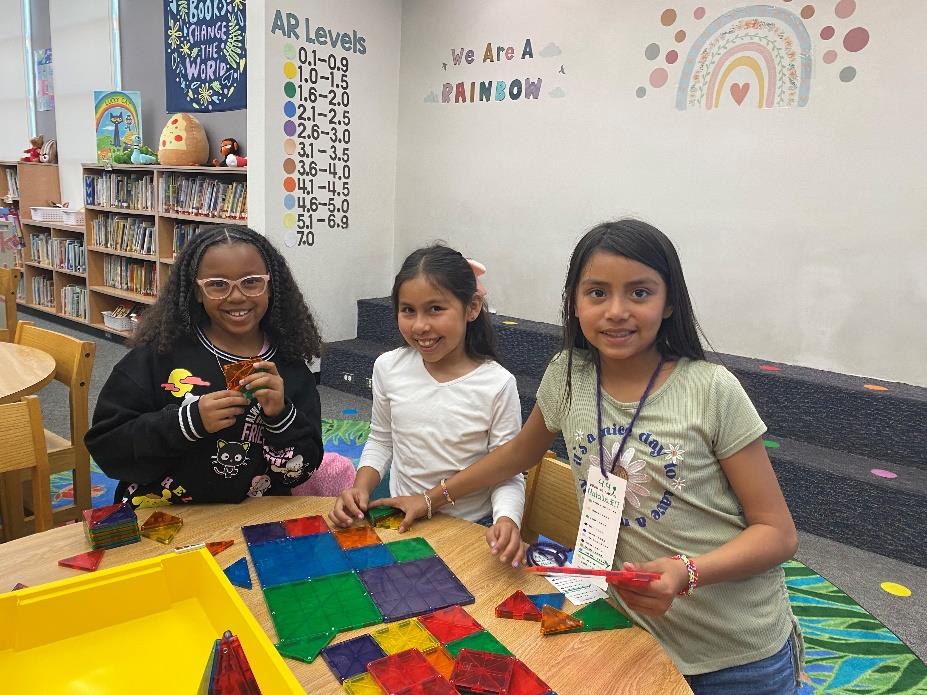Applicant’s Name: Norine Leverton
School: Farr Avenue Elementary School Project
Title: Mobile Makerspace Cart Dollar Amount: $5,000
Subject Area: Library
Grant Type: Classroom Project
Grade Level: TK – 5th
Number of Classes That Participated: 25
Number of Students That Participated: 500
Evaluation Questions:
What empirical evidence, if any, do you have to submit to evaluate your project?
The mobile makerspace cart has provided our school library with valuable hands-on learning experiences that have fostered creativity, collaboration, and problem-solving skills. The empirical evidence I witnessed included enhanced engagement, particularly for our special needs students. Student’s eyes lit up as they chose their maker station activity and I witnessed students collaborating as team members and problem solving together. I introduced the makerspace cart during STEAM week and read students a book about what it means to be a “maker.” I love that the makerspace cart prepares students for future careers in STEAM by developing crucial skills like critical thinking and communication.


What observations have you recorded and reviewed as evidence your project was successful? Where do you think you could improve?
After introducing the makerspace cart to our school library, I observed the large positive impact it had on our students. I began by introducing the mobile makerspace cart to students during STEAM week in the library. During this week, we read a STEAM book and then students were able to choose a maker station table, which included building sets from the cart. As I walked around the room, I was impressed by the level of enhanced student learning and engagement. I loved how the building sets encouraged natural collaboration and fostered a love for learning as students took ownership of their projects. The concepts we read about in our read aloud book that day were brought to life as students used the hands-on activities, which lead to deeper understanding.
I noticed that the makerspace activities were particularly beneficial for our special needs students, helping them develop problem-solving, creative thinking, communication, and vocational skills. Using the makerspace cart in the library also provided a structured environment that catered to diverse learning styles, making learning more accessible and engaging.
During STEAM week, I discussed with students the different career options in the field and the makerspace cart reinforced this by equipping students with valuable skills and knowledge that can be applied in the real world. My favorite observation was seeing student’s creativity and innovation. I noticed students’ self-confidence soar as they proudly showed me their creations. I loved seeing students experiment, learn from their mistakes and each other, and come up with unique solutions. The makerspace cart has been a great addition to our library because it fosters community and further strengthens that our library is a safe space for students to develop their interests and be creative. Students are also developing 21st century skills for success in today’s ever-changing world.




If you continue with this project next year, what would you do differently?
I plan to continue using the makerspace cart in the library for years to come. It has been a wonderful addition to our library space and I have seen countless benefits with our students. I love that makerspaces can change people’s perception of libraries, inspiring reluctant readers and encouraging broader usage of the library services. While most teachers were excited and curious about our new maker space in the library, there were a few teachers who were hesitant it may take over our whole library program and replace books. This is a common worry among educators but I was excited to use this as a teaching opportunity to show teachers the benefits of maker spaces in libraries and a new approach to 21st century learning. I did this by sharing an article with teachers about the many benefits of maker spaces in libraries and as I slowly introduced the cart to students and went over the expectations, I saw teachers open up to this new concept in our library space. I created a form to allow teachers the option of opting in or out of using the makerspace cart during their library time and most teachers opted in. Right now classes are only using the cart at the librarian’s discretion so we use it when time permits in our library program schedule.
Another concern raised by teachers was that if the makerspace cart was mobile and could be checked out to classrooms and moved around the school, we might lose pieces of the building kits. My solution to this has been to use the building kits in the library at table stations and check out only the craft consumables and STEAM kit project drawers individually to teachers to use in their classrooms rather than moving the whole cart. This way I can better manage the items and ensure that materials are being used responsibly and prevent loss of materials. Overall, the makerspace cart has helped our library uphold its core values of information literacy, critical thinking, and lifelong learning and has been an amazing addition to our space and for our students!
